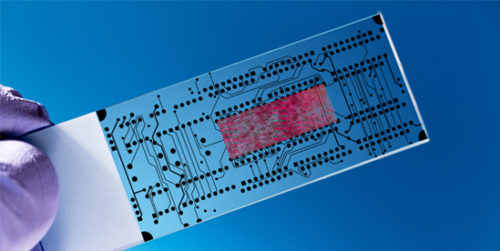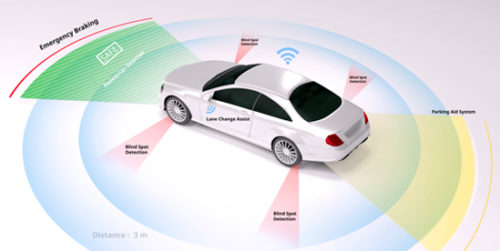Mosaic Microsystems is proud to serve a number of industries and support their business goals with our proprietary technology. Please find more information below on how Mosaic is uniquely poised to deliver for clients in various markets.
RF
 Wireless communication is pervasive in our society as we use our mobile devices to connect and control more and more aspects of our everyday life. This drives a huge appetite for increased communication speeds and data storage. The emergence of 5G including mmWave communication drives the need for new solutions that can perform at higher and higher frequencies.
Wireless communication is pervasive in our society as we use our mobile devices to connect and control more and more aspects of our everyday life. This drives a huge appetite for increased communication speeds and data storage. The emergence of 5G including mmWave communication drives the need for new solutions that can perform at higher and higher frequencies.
Thin glass provides solutions to address these challenging needs. Glass is inherently a low loss material and can be formed with low roughness and thin, large area formats. This makes glass an ideal substrate to provide thin, cost-effective solutions for next generation RF needs.
Package Substrates
 There is an ongoing need for interposers for digital applications that require high bandwidth, low latency, and low power, allowing for tight electrical integration of multiple heterogeneous die with fine pitch lines and through vias to connect top chips to backside components. These packaging solutions need to be thin to address the form factor needs of current devices.
There is an ongoing need for interposers for digital applications that require high bandwidth, low latency, and low power, allowing for tight electrical integration of multiple heterogeneous die with fine pitch lines and through vias to connect top chips to backside components. These packaging solutions need to be thin to address the form factor needs of current devices.
Thin glass is formed with sub-nanometer roughness and in formats > 1 meter in size. Furthermore, glass is stable with temperature and humidity, and the composition can be chosen to have thermal expansion properties to manage the stress in the package. Since glass can be formed thin (100 um and below) and in large formats, cost-effective solutions are available. Mosaic’s proprietary handling solution makes these solutions possible.
MEMS
 MEMS devices have become pervasive and essential for applications including devices for micro-fluidics, switches, transducers and optical sensing. These devices do everything from lab-on-a-chip, to sensing the tire pressure in our automobiles to enabling our functionality of mobile phones and wearable devices.
MEMS devices have become pervasive and essential for applications including devices for micro-fluidics, switches, transducers and optical sensing. These devices do everything from lab-on-a-chip, to sensing the tire pressure in our automobiles to enabling our functionality of mobile phones and wearable devices.
Glass plays an important role in many of these applications. The transparency and chemical inertness of glass is important for many optical and biological applications. Since glass does not absorb water and is very smooth, it provides an attractive solution for hermetically sealed microelectronic devices.
Sensing
 Optical sensing has become pervasive in automotive, mobile communications, life sciences and generally for the Internet of Things (IoT). Glass has traditionally been an excellent substrate for both additive and subtractive structuring of glass surfaces.
Optical sensing has become pervasive in automotive, mobile communications, life sciences and generally for the Internet of Things (IoT). Glass has traditionally been an excellent substrate for both additive and subtractive structuring of glass surfaces.
Being able to process directly on thin glass substrates allows you to avoid expensive post-processing steps. Mosaic’s thin substrate handling technology provides a cost-effective way to fabricate precision sensing components on thin glass substrates.
Photonics
 Our increasingly connected world creates a need to continually establish solutions for higher data rates and manage immense amounts of data in the cloud. Photonics provides increasingly important solutions to address these challenges.
Our increasingly connected world creates a need to continually establish solutions for higher data rates and manage immense amounts of data in the cloud. Photonics provides increasingly important solutions to address these challenges.
Glass has a number of advantages for photonic applications. It is transparent at wavelengths used in fiber optics and optical waveguides can be fabricated with lasers or thin films on or below the surface. Further advantages are seen in assembly since fibers can be attached directly to the glass substrate with laser fusion.
